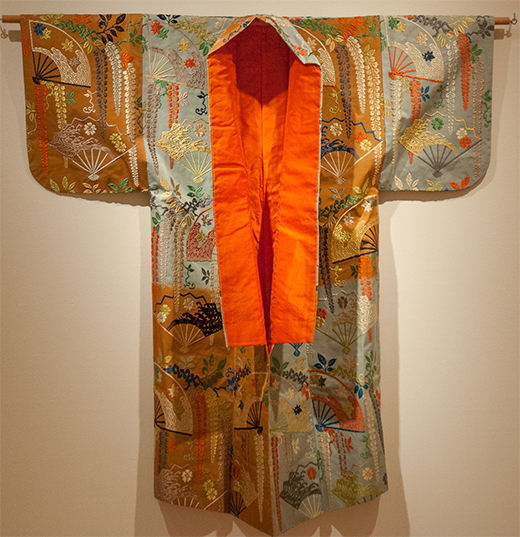
Noh Theater Robe, ca. 1920s, silk on fabric, Scripps College, Claremont, CA
In the Japanese tradition of Noh theater, genders and types are revealed through traditional and ritualized actions, and are coded within the costumes. In the case of this short-sleeved silk robe, or kosode, the auspicious symbols embroidered thereon indicate the types of characters by whom it might be worn. This embroidery technique, called karaori, first emerged during the Momoyama period (1573–1615 CE) and became commonplace and codified soon thereafter, even when it was rarely used in everyday clothing. The robe is decorated with wisteria flowers and fans with maple leaves, understood as spring and autumn flora, respectively. These motifs date back to the Heian period (c. 794–1185 CE) and are associated with ideals of Japanese feminine beauty, characterized by refinement, elegance, and sensitivity. Women’s patterns typically include softer, vegetal designs of the four seasons, in contrast to sharper, more geometric men’s designs, which might incorporate Buddhist symbols. Thus, the character represented by this robe would be a woman, though the actor depicting that character would be a man.
Women were excluded from participating in the Noh until the early 20th century, when they were allowed to practice it as a hobby. Although this robe was probably created in the 1920s, it is unlikely that it would have been worn by a female actor, as it was still rare for women to perform.
In the portrayal of female characters on the Noh stage, the audience was always acutely aware of the performer’s gender in contrast to the role he assumed. There was no attempt to trick the audience: for example, the jaw of a middle-aged actor would be visible under the mask of a beautiful, young woman. Specific instructions were written for these actors in treatises, such as those of Zeami, a writer and theorist of the Noh active from the late-14th to mid-15th century. He suggested that male actors hold fans or flowers; keep their hips and legs straight; and remain loose throughout the neck and face in order to evoke the sensitivity necessary to appear feminine. The movement of the body and the costume were crucial to the actor’s performance of a feminine role; this kosode helps to construct the image of a woman through shape, color, and motif.
Marielle Epstein, Wilson intern, SC ’18
Works Consulted
Denney, Joyce. “Noh Costume.” In Heilbrunn Timeline of Art History. New York: The Metropolitan Museum of Art, 2000.
“Gender Crossings: Women in Noh.” On the Bridgeway, 22 Apr. 2014
Patterns and Poetry: Japanese No Play Robes from the Lucy Truman Aldrich Collection at the Museum of Art, Rhode Island School of Design. 1993.
Zentarō, Kitagawa. “Traditional Culture & The Recreation of Noh Costumes.” Sculpture in Silk: Costumes from Japan’s Noh Theater, Art Capital Group, 2003, pp. 5–15.

